The first calibration produces a good starting base for the K values. They are imported to the mesh file via Attributes  Import model data/calculation results.
Import model data/calculation results.
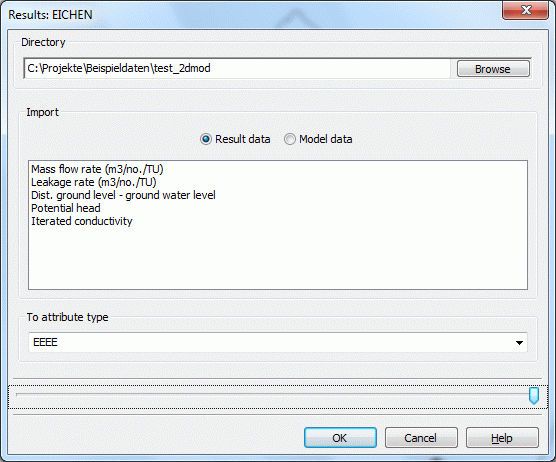
Import of results
When the attribute "KWER" is selected, the existing K values are overwritten. To avoid large jumps of the K values in adjacent elements, the K values are smoothed as follows:
Attributes  Computation
Computation  Smooth: "KWER". The weighting factor is set to 0.5, and the weighting type is preset to "linear". The mesh file is saved. Then the model is inspected (Calculation
Smooth: "KWER". The weighting factor is set to 0.5, and the weighting type is preset to "linear". The mesh file is saved. Then the model is inspected (Calculation  Model checking), a flow calculation (Calculation
Model checking), a flow calculation (Calculation  Stat. flow) is carried out with 5 iterations and the module GEONEU (
Stat. flow) is carried out with 5 iterations and the module GEONEU ( Advanced settings), and a new plot is generated using the previously saved "plo.bpl" batch file. The result is shown on the following picture:
Advanced settings), and a new plot is generated using the previously saved "plo.bpl" batch file. The result is shown on the following picture:
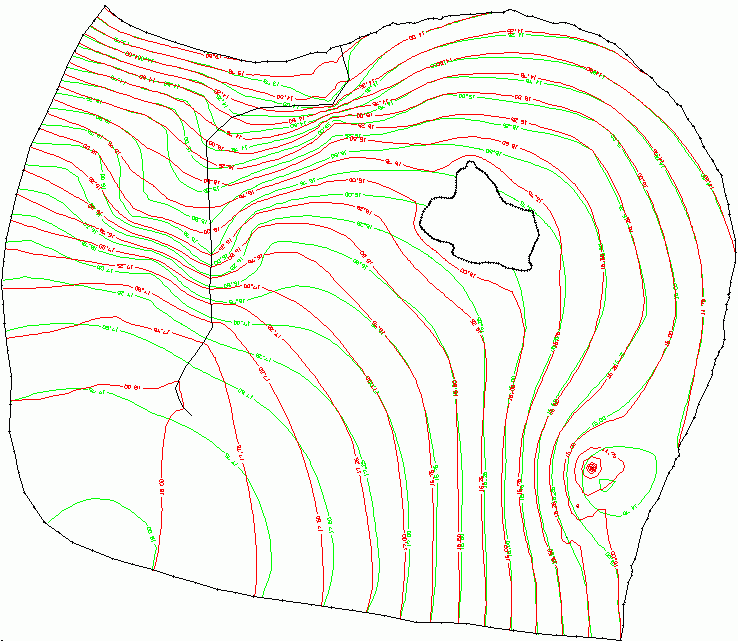
Contour lines with difference plot after smoothing of the K-values
The maximum deviation at the measuring points is 0.50 m, the average being 0.09 m.
The curve of the isolines in the upper reach of the water course indicates an infiltration of the stream water into the groundwater. Upon "crossing" the water course, the isoline "17.75 (red)" forms a tip in the direction of flow of the water course.
Since this is not in line with the actual situation (stream bed is probably dry), the parameter MXKI is assigned the value 0.0 at the last 14 nodes, i.e., an infiltration is prevented (Attributes  Assign
Assign  Direct).
Direct).
After performing the model inspection, carrying out a steady-state flow calculation and generating the plot, the following picture is obtained:
The infiltration in the upper reach of the water course has been eliminated. The curve of the isolines is more plausible, but the average deviation of the measuring points has deteriorated. The maximum deviation is now 0.39 m and the average 0.17 m. A large portion of the model seems to contain too little water!
It seems logical to start another calibration using the parameters modified up to now. The result is shown on the following picture:
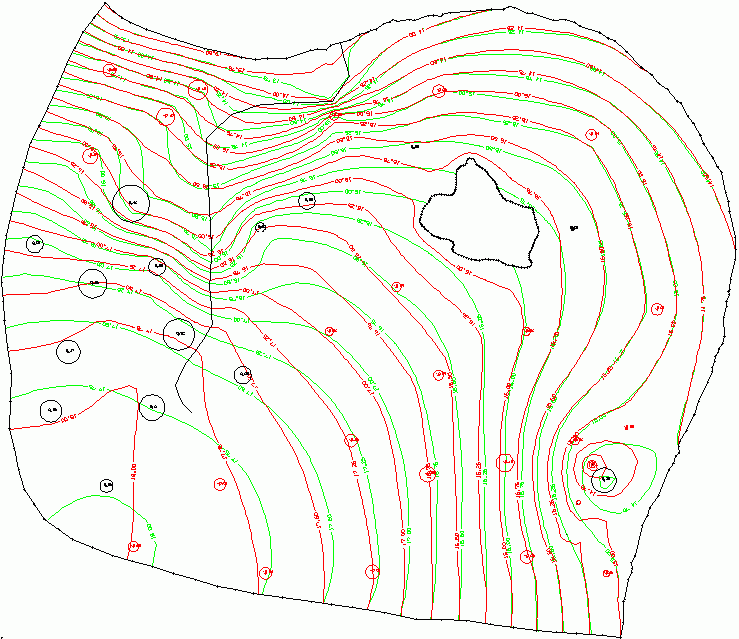
Contour lines with dofference plot following a new calibration
Finally the iterated K values are copied to the mesh file, and a new flow calculation is carried out.
The updated mesh file “s4_kalibriert.zip” (Download on our homepage, *.zip) gives the following picture:
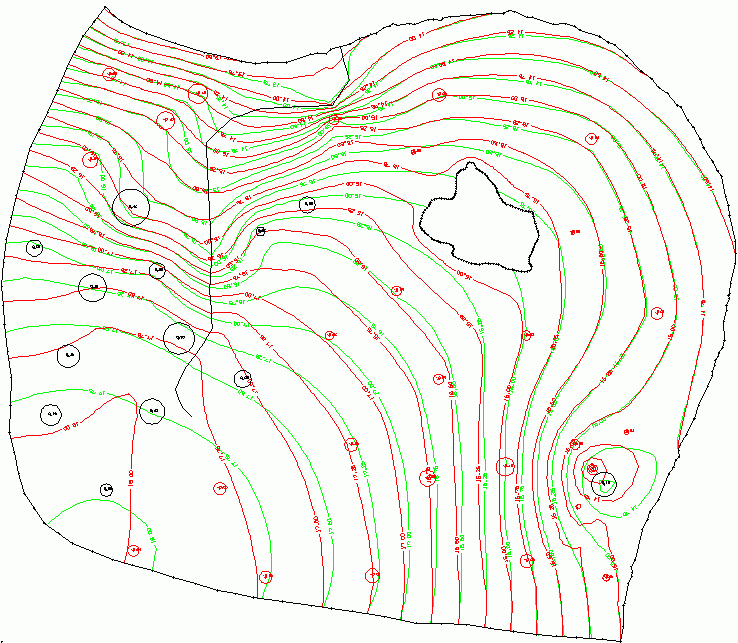
Contour lines with difference plot of the calibrated model
The deviations at the measuring points are at most 0.41 m and on average 0.08 m. This is considered sufficiently accurate for the example model.
The distribution of the permeabilities now looks like this:
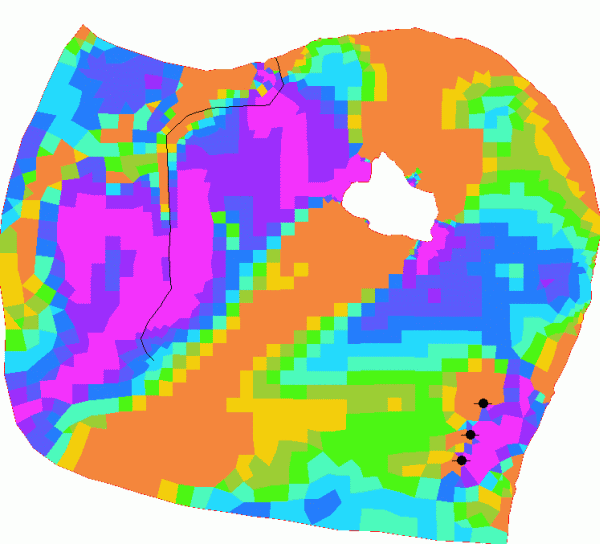
Distribution of the calibrated permeabilities
The permeabilities were displayed in the interval 1.0e-06 to 0.002 within 10 ranges of values (via View  Show attributes
Show attributes  Isolines/Area plots/Values). Upon clicking on View
Isolines/Area plots/Values). Upon clicking on View  More windows
More windows  Project manager the layer list appears in a new window in which the arrangement of the individual layers can be changed via drag&drop.
Project manager the layer list appears in a new window in which the arrangement of the individual layers can be changed via drag&drop.
(Note: "Top" in the layer list corresponds to all the way at the back, "Bottom" corresponds to all the way at the front). To display the legend of the corresponding layer, click on the check box.
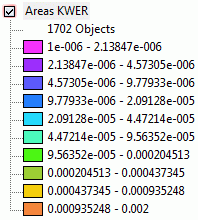
Legend of the permeabilities [m/s]
A stepwise model calibration can look like the one described, but it always requires knowledge by the user on the local situation and cannot be carried out by the book. Moreover, a calibrating should always end with a plausibility check of the (iterated) parameters.
The next step is General information on calibration 
